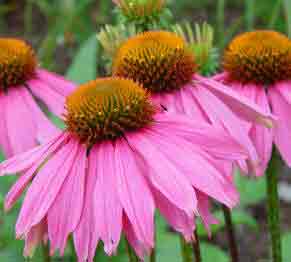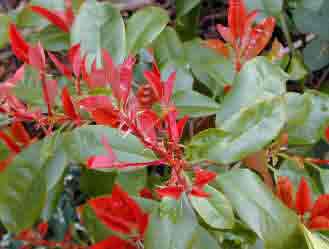Planting Perennials - How to plant container grown plants
The best time for planting perennials is normally in the autumn or early spring, but as with all plants for the garden now, they can be bought all the year round as potted plants, and so can be planted at any time of the year.
Perennials planted in late spring and summer, will need a little bit of extra care to ensure that they establish properly. In particular, they will need regular watering to allow their root system to establish into the surrounding soil.
Drying out of newly planted plants in summer is one of the main causes of death! They will need watering when conditions are dry, right through from spring until leaves fade - naturally - in autumn.
There is a general feeling that because a plant or shrub has been container-grown for a few months or even years, then it is easy to plant and establish. This is not always the case!
The reason for so many planting failures of container grown plants is simply because it is not appreciated what has happened in the growing nursery prior to purchase, and worse still have very little understanding of the stress that the plant will have to endure upon removal from the container, and planting into the garden.
Transplanting Shock!
 Before
it is taken to the retail area of the nursery or garden
centre, the plant will have had a very comfortable and
cared-for life. It will have become settled in its
container – even though ideally it needed to spread its
roots to at least the circumference of the plant that
they are supporting. Water and food were on tap at
all times and generally it had a pleasing growing
environment.
Before
it is taken to the retail area of the nursery or garden
centre, the plant will have had a very comfortable and
cared-for life. It will have become settled in its
container – even though ideally it needed to spread its
roots to at least the circumference of the plant that
they are supporting. Water and food were on tap at
all times and generally it had a pleasing growing
environment.
It is the restricted root area combined with an artificially fed and watered plant that you will be taking home to your garden environment, which is the problem. Understand that, and you are on the way to a successful planting operation, and no need to return the plant to the garden centre, simply thinking that it has died on you!
Transplant shock affects spring and summer planted container grown plants – sometimes more than if the plant were field grown and transplanted bare root in the autumn! It is wrongly assumed that a pot grown plant will have not transplanting problems.
The problem with planting a container grown plant in the summer or spring, is the fact that the top of the plant, will want to grow in the warm air conditions. It will take the roots several weeks – or even months depending upon size – to be able to grow into the surrounding soil and support the plant with nutrients and water the way it should. The area and volume of the root system on many container grown plants will in fact only be 50% of what it should be!
Basic Preparations to reduce Transplant Shock
1. Soak the root-ball of the plant whilst it is still in the pot. Depending upon size, this will need to be done for between 1 and 8 hours before removal of the plant from the pot. This action will go a long way in preventing severe shock upon planting.
2. Dig a hole that is large enough to comfortably take the size of the root system. This can either be the same depth as the put or a little deeper. It should be around twice the diameter of the plant pot, so that you have plenty of room around the planted plant to enable good back-filling around the plant. Place to plant – complete with pot in the hole and ensure that there is enough depth. If the hole is too deep, simply backfill with garden earth or compost, and compact it so that once watered, the plant will not sink lower into the ground. You should be aiming at getting the top of the existing pot soil at the same level as your existing ground. If slightly lower, it is no big deal.
3. Water the planting hole well – even allowing a few cm of water to la in the bottom until it soaks away.
4. Tap the plant out of the pot, or gently remove it if the compost is not firm and make sure that it all fits well. If the rootball is higher than the surrounding soil, do not carry out planting until you deepen the hole.
5. IMPORTANT!! I If the planting area is newly made-up soil, it will sink over time. This could leave you’re the roots of the plant exposed as the soil around it subsides.
6. Once the plant is in the hole – and secured if need be, then back fill the hole in stages with non-lumpy top soil, or with some potting or planting compost, making sure that it is well firmed around the root ball of the plant. This is very important, for we need to get the root system in contact with the surrounding soil as soon as possible. NB – The best way to consolidate the soil around the roots, is by watering well. You will probably find that this will leave a depression around the plant as the soil sinks. As long as the top- surface of the root ball is no higher than the ground, there is no need to fill in this depression. Leave it for a few weeks to help with watering around the plant. Once the plant is settled, you can then fill in the depression.
7. Aftercare consists mainly of watering as and when required. Do not have the soil permanently soaked.
Aftercare and Watering
Many nurseries incorporate a long-term fertiliser in their compost. This can actually deter the root system from moving out into its new home! This is one of the reasons why all the preparations above are necessary.
Don't forget that your herbaceous perennial is going to be in the same place for many years. Make sure that the soil where it is to be planted has been well manured and fed, as well as being dug over to break up the soil. This will allow air into the root zone of your newly planted herbaceous perennials.
Many perennials are available as mail-order plants, but there is usually a good range at most garden centres also.
Plant them as normal – a trowel is normally the best tool – and add a little bit of rotted compost or multi-purpose potting compost to the planting hole. Make sure that the perennials are firmly planted, and that the soil is pushed well down into the planting hole. Give them a good soak of water. This will also help to settle the soil down around the plant roots.
Leave enough space around these small plants for them to grow into their proper size! As well as using a plant label, it might be a good idea to make a note of the names and positions for future reference, in case and inquisitive squirrel makes a run for it with your labels!
A few days after planting – not in very hot weather – you can give your new perennials a week feed of Tomato feed – just to help it on its way in its new home.
Plant Support
Taller perennials will need support – either with a single cane if they are just a few stems or perhaps with some twiggy branches if they are twining plants. You can also get a range of ornamental supports from any garden centre. It is better to do this at planting time, for once your perennials start to grow, the growth rate is normally quite quick! If your garden is in a very exposed situation, it will probably be better if you use shrubs as the taller plants, and then plant lower growing perennials in sheltered places.
Best Selling Gardening Products
Popular Gardening Sections

Problems
Identify Weeds in The Garden - How to deal with weeds. Diseases and Pest which harm your garden and plants, learn how to prevent, deter and erradicate your garden problems.
Garden Problems
Pruning
Pruning Guide. Shrubs flower better with correct pruning. Many illustrations and examples of what to do - and when. Includes evergreens, roses, flowering shrubs, spring flowering shrubs and pruning for stem effect. This is our most viewed and comprehensive section,
Pruning
Gardening Businesses
Gardening Businesses listed in the UK counties and USA states. County and State Listings of businesses involved in Garden supplies and services. If you wish to be added to the Directory, please send us your information. Having problems, use the search box
Businesses
Gardening
In this section you will learn about Gardening Basics, Containers, Landscaping, Propagation and Soil.
Gardening
Gardening Gifts
Gardening Gifts and Reviews, Read Before you Buy
- Gardening Gifts Ideas
- Gifts For Her
- Gifts For Men
- Power Tool Gifts
- Cheap Gifts
- Personalised Gifts
- Wildlife Gifts
- Family Gifts



